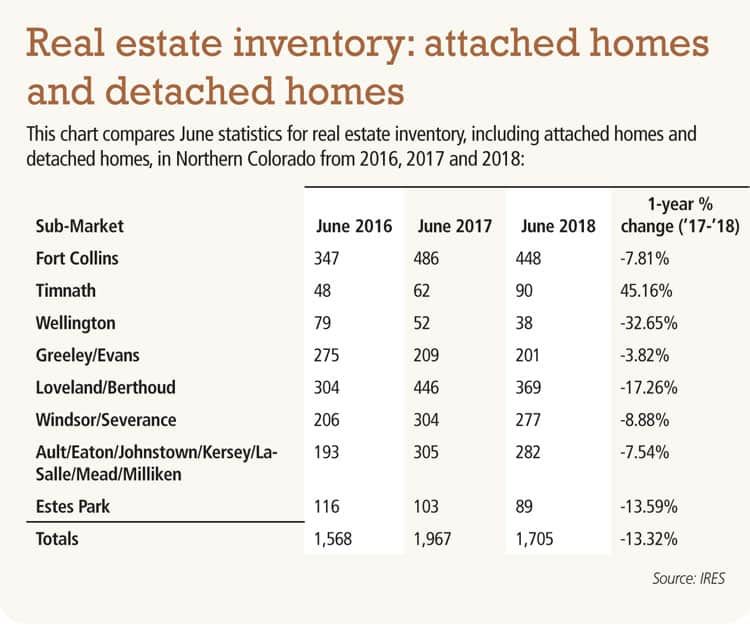Buyer’s market or seller’s market? It depends


 Northern Colorado is in a seller’s market, right?
Northern Colorado is in a seller’s market, right?
Hard to argue otherwise. After all, the region’s supply of homes for sale has held low for several years running, demand maintains a steady simmer, and average prices keep climbing.
From a 30,000-foot view, that’s a reasonable assessment. But identifying a seller’s market or buyer’s market requires a closer look — maybe even as close as a neighborhood, a city block, or a specific property. Through that lens, you’ll see that Northern Colorado is a patchwork of seller’s and buyer’s markets.
SPONSORED CONTENT
Empowering communities
Rocky Mountain Health Plans (RMHP), part of the UnitedHealthcare family, has pledged its commitment to uplift these communities through substantial investments in organizations addressing the distinct needs of our communities.
Traditionally, a balanced market is defined as six months of supply — meaning it would take six months to sell all available homes at the current pace of sales. Less than six months gives the advantage to the sellers, resulting in more competition for less supply, and upward pressure on prices. When the supply dwindles down toward one month, you see multiple offers from buyers, and the elimination of contingencies.
A buyer’s market occurs when supply is greater than six months. That’s when buyers enjoy more houses to choose from, and consequently more leverage on price. The spread between the original list price and the eventual sales price gets larger, as sellers are forced to adjust their pricing strategies to make their properties more competitive.
With these descriptions, we can begin to recognize the patchwork we discussed earlier. Different locations and price points are experiencing different levels of demand. Using price ranges as a guide, let’s examine where the seller’s markets are the strongest and where some buyer’s markets exist across Northern Colorado:
$300,000-$500,000. Understandably the most popular price point for buyers, and definitely a seller’s market wherever you go. In Fort Collins, Greeley and Loveland, the supply of homes in this range was at one month or less as of June, and sellers were getting about 101 percent of the original list price. In Berthoud, there was a three-month supply of homes in this range, and the average sale fetched 100.3 percent of the original price.
$500,000-$700,000. Supplies in this segment ranged from 1.6 months (Fort Collins and Greeley) to four months (Loveland and Berthoud). But the seller’s percentage of list price was less predictable — as high as 101.3 percent in Loveland and as low as 97.6 percent in Greeley.
$700,001-$1 million. Signs of a buyer’s market for those shopping in this price range. Only in Fort Collins was supply at less than six months (4.4 months). Greeley, Loveland and Windsor all reported at least seven months of supply. But Greeley sellers got 100.6 percent of their asking price, while the Fort Collins sellers only brought in 96.2 percent.
$1 million-$1.3 million. A small sample size here, so only Fort Collins had enough sales in this price range to warrant analysis. The supply was 8.5 months, and percentage of list price was just 85.5 percent.
A number of variables, including location, price, and the condition of the home, will help or harm any property from bucking the statistical trend. A house in this market located in a highly desirable location and in superior condition will always rise to the top of the supply chain.
The ongoing challenge is that everyone holds their home in the highest regard and typically has a hard time looking objectively at its location, price, and condition. Knowing your local market supply is critical as you get ready to sell or buy. Reading headlines can be deceptive and lacks the hyperlocal focus necessary to establish realistic expectations.
Brandon Wells is president of The Group Inc. Real Estate, founded in Fort Collins in 1976 with six locations in Northern Colorado.

 Northern Colorado is in a seller’s market, right?
Northern Colorado is in a seller’s market, right?
Hard to argue otherwise. After all, the region’s supply of homes for sale has held low for several years running, demand maintains a steady simmer, and average prices keep climbing.
From a 30,000-foot view, that’s a reasonable assessment. But identifying a seller’s market or buyer’s market requires a closer look — maybe even as close as a neighborhood, a city block, or a specific property. Through that lens, you’ll see…
THIS ARTICLE IS FOR SUBSCRIBERS ONLY
Continue reading for less than $3 per week!
Get a month of award-winning local business news, trends and insights
Access award-winning content today!

